Hyundai ix35 Fuel Cell: El Reg on the hydrogen highway
Hyundai ix35 Fuel Cell: El Reg on the hydrogen highway • The Register
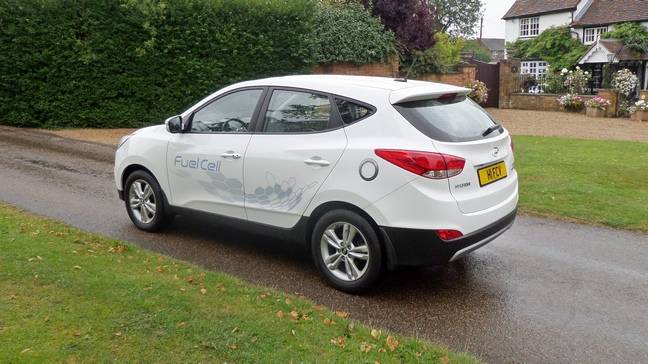
Hyundai reckons we will be seeing these things all over the place by
2030. Good effort from a company that a decade ago was making the Accent
and Matrix!
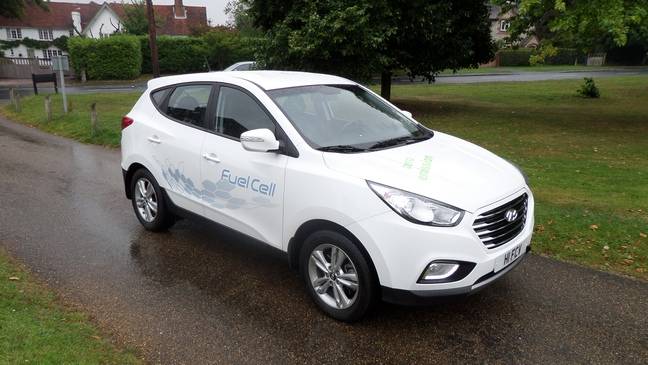
Hydrogen comes from water. A good thing judging by the amount of rain that fell during our day with the ix35 Fuel Cell
Fuel tanks account for one third of the cost of the vehicle and are rated to 10,000psi, apparently
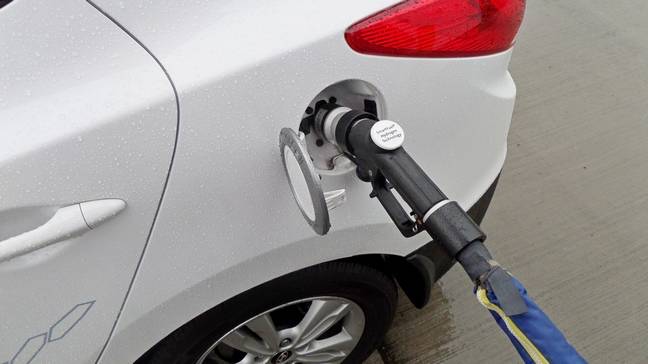
Recharge...sorry, refill, takes three minutes. No steeenking hydrocarbons here meester
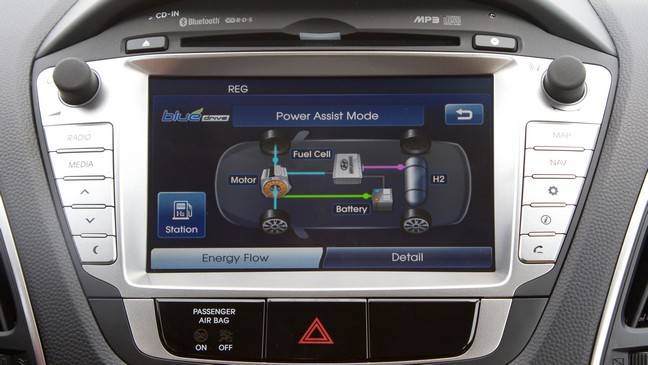
Hydrogen fuel cell, battery and regenerative braking all work together to get you down the road. Feels much like any other EV
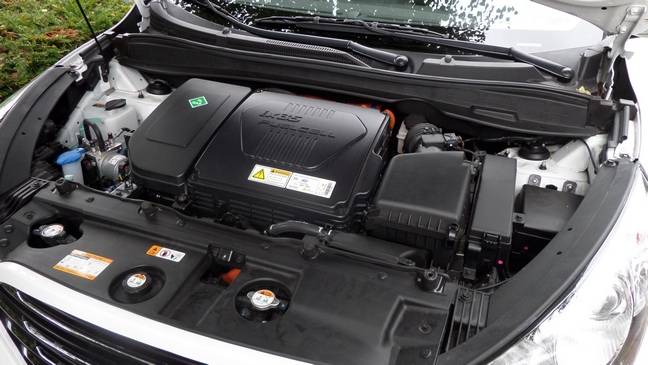 100kW electric motor gives the ix35 Fuel Cell decent performance. 0-62 yours in 12.5 seconds but feels faster on the road
100kW electric motor gives the ix35 Fuel Cell decent performance. 0-62 yours in 12.5 seconds but feels faster on the roadLHD only. And no 4WD. And a £50,000 price tag. So not quite mainstream yet
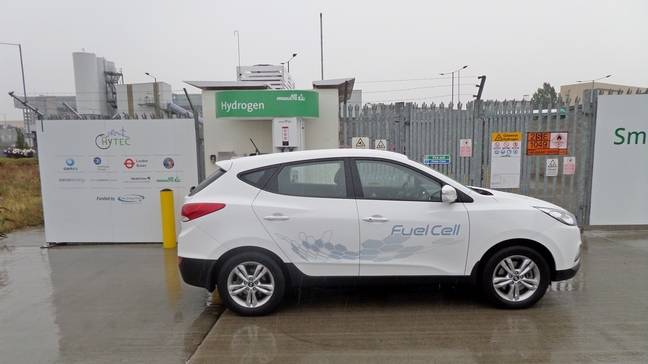
The ix35 at the hydrogen filling station near Heathrow. One of three in the UK at the time of writing
Ask me what my ideal electric car would be and I’ll probably tell you
one with a range of 400 miles and a three-minute charge time. Shame no
such car exists, I hear you say. Not so. I drove just such a vehicle
last week.
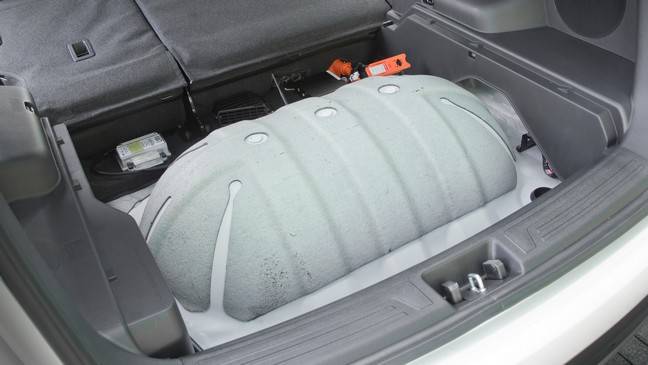 demonstration, part run-of-the-mill, commercially available motor
demonstration, part run-of-the-mill, commercially available motor vehicle. Right now you can buy one off the shelf from Hyundai UK, though
there are certain compromises to be made.
All the vehicles on sale or already sold in the UK
(and that’s exactly 17 at the time of writing) are LHD thanks to the
fuel cell sitting where the steering column would need to be.
And they are all front-wheel drive only because one
of the hydrogen fuel tanks takes up the space needed by the gubbins that
usually drives the back wheels. Oh, and it will cost you over fifty
grand. And, erm, there are only three hydrogen filling stations in the
UK right now.
But if you can overlook those four drawbacks the ix35
Fuel Cell is a highly desirable little wagon which drives just like any
other good, modern EV but without any of the range restrictions imposed
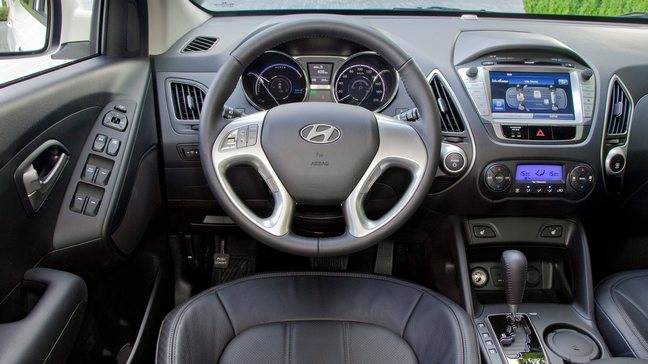 by current battery technology.
by current battery technology.Motive power is supplied by a 100kW (136ps) electric
motor which in turn is connected to a 24kWh lithium-ion polymer battery
jointly developed by Hyundai and LG Chemical. The drive motor takes
power from either the battery or a combination of the battery and the
100kW hydrogen fuel cell, depending on driving conditions.
The battery meanwhile can be charged by the fuel cell
and by the regenerative braking system. When you do put your foot down
the ix35 will hit 60mph in 12.5 seconds and roll up to a maximum speed
of 100mph.
Of course as will all electric cars those performance
numbers are rather meaningless. The always-available 300Nm of torque
makes for very eager and serene progress at all speeds up to the legal
limit. It’s impressively quiet too, and agile.
The last came as a bit of a surprise to me since the
ix35 FC has to carry an extra 150kg around compared with the petrol
version. Hyundai’s engineers have done a good job keeping the centre of
gravity as low as possible and in tuning the suspension to cope with the
extra weight.
Refuelling the ix35 couldn't be simpler. Just roll up
to a hydrogen filling station (right now there are stations at
Heathrow, Hendon and Swindon and three coming to London by year end),
pop the filler cap cover, plug in the 700 bar hydrogen fuelling nozzle
and ... well that’s it.
It’s just like filling up a petrol car just without
the stink of hydrocarbon fumes. Refuelling the ix35 from empty takes
about three minutes. Despite the fuel cell power source the ix35 is as
wholly unremarkable to operate as it is fill up. In fact driving the
thing is as easy as falling off a wet log. Just press the power button
and put the drive selector into D and away you go.
How does all this fuel cell malarkey work? Well, in a
polymer electrolyte membrane or PEM fuel cell like the one in the ix35,
hydrogen is used to generate electricity via a chemical reaction.
The basic component of a fuel cell is composed of two
electrodes – a negatively charged anode and a positively charged
cathode. The anode is supplied with hydrogen and the cathode with oxygen
(extracted from the air) but although the hydrogen molecules are
attracted to the cathode, the membrane is designed to allow only the
protons to pass through, not the electrons.
The H+ ions (the protons minus their electron) pass
through the membrane, combine with the oxygen to create the only
by-product of the process, H2O or water. The electrons, meanwhile, are
blocked at the anode level and can only move in an external circuit,
thus generating an electric current.
Between them the two fuel tanks in the ix35 can take
5.64kg of hydrogen which according to the trip computer is good for 370
miles (595km). I’d not been driving the thing particularly gently for
the 60-odd miles before I topped it up so I have no reason to believe
the car was telling porkies.
Doing direct miles-per-gallon comparisons with petrol
is a little tricky. But since the ix35 gets about 106km from 1kg of
hydrogen and since 1kg of hydrogen can produce a similar amount of
energy to 3.7 litres of petrol you could say it’s doing the equivalent
of about 29km per litre. Or just over 80 miles per gallon.
Toward the end of my day with the ix35 it dawned on
me that what I was in effect driving was a range extended EV with a fuel
cell power supply.
That’s seemingly Hyundai’s thinking because the next
generation car due in 2017 (again a mid-sized SUV but this time
available in RHD) will have a much higher capacity battery, a slightly
less powerful electric motor, a more aggressive regenerative braking
system and a higher power-to-weight ratio thanks to a lower kerb weight.
So much for the car, but how much does pump hydrogen
cost to the motorist? Mmmm, bit of a grey area, as currently the only
users are commercial and they negotiate a price in advance. Hyundai
tells me it pays about the same to fill up a hydrogen ix35 as they would
a petrol version, so around £70 or £12 per kilogram.
When it comes to the long-term hydrogen supply line
Hyundai UK is both bullish and pessimistic. Bullish because the supply
is already there, as “brown” hydrogen is currently vented during
existing industrial processes, and potentially there could be “green”
hydrogen extracted from water using excess capacity from either nuclear
or wind and solar electricity generation.
Hydrogen is a handy way of storing energy from power
sources that you can’t just turn off like a conventional gas or coal
power station.
Pessimistic because I get the impression that like
all the green and alternative energy community in general, Hyundai has
no idea what the hell this current government is up to when it comes to
renewable energy and low emission transport.
My own view? When the hydrogen highway becomes a
reality expect to drive it in Denmark or Germany not the UK where such
matters are dismissed as "green crap".
The initial cost of ownership is of course also an issue. The ix35 costs £53,105 (though that's before any OLEV rebate) which is a lot for mid-size Korean SUV.
Surprisingly nearly a third of that cost is the
hydrogen fuel tanks, sourced from a manufacturer in the US who are
pretty much the only people who make them. The next generation car will
use a storage tank built in-house. Incidentally the fuel tanks are rated
to 10,000psi and are pretty much indestructible.
Currently, those fuel tanks and a couple of exotic
filter elements in the fuel cell stack are the only non-Hyundai parts in
the vehicle. That’s a impressive for a car maker that only a decade ago
was making cheap automotive tat.
It’s in line with Hyundai’s ambitions in the
alternate fuel car arena though. Next year Hyundai will launch a new
model in Europe that will be available as a hybrid, a plug-in hybrid and
a pure-EV.
How does Hyundai see the fuel cell electric vehicle
future? It reckons there could easily be more than 1.6 million fuel cell
vehicles on the UK’s roads by 2030 with 300,000 more being sold each
year. By 2050, it thinks fuel cell vehicles will be on course to take as
much as 50 per cent new car market. Bold predictions indeed.
The Reg Verdict
It’s early days for hydrogen automobiles but if theix35 is anything to go by the future is bright. Yes as it stands the
vehicle is prohibitively expensive (though Huyndai claim it’s not
actually making a loss on each one sold) and the refueling
infrastructure is very sparse, but the technology certainly works.
Overall, the ix35 Fuel Cell is a very fine electric vehicle and the hydrogen refuelling station was piece of cake to use.
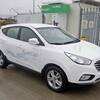
Hyundai ix35 Fuel Cell: El Reg on the hydrogen highway
Hydrogen fuel cell-powered electric SUV with a 370
mile range and three minute refuelling time. Only available in left-hand
drive and front-wheel drive though. And at over £50,000 not cheap.
mile range and three minute refuelling time. Only available in left-hand
drive and front-wheel drive though. And at over £50,000 not cheap.
Price:
£53,105
RRP
£53,105
RRP

Комментариев нет:
Отправить комментарий
Примечание. Отправлять комментарии могут только участники этого блога.